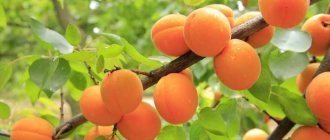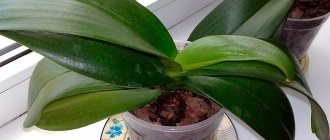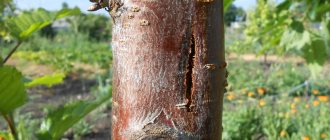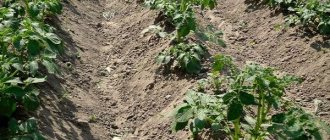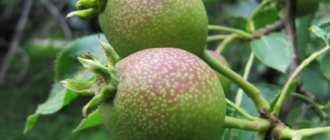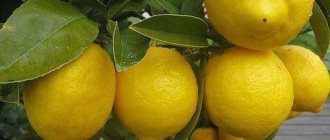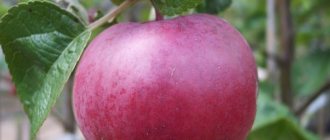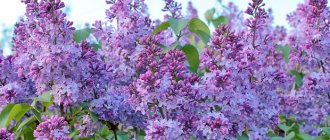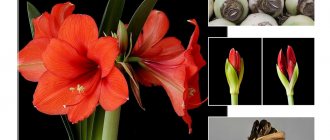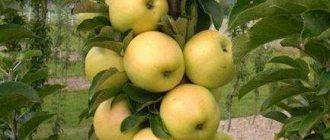Apple trees are a long-term project for gardeners; the first harvest can be obtained no earlier than five years after planting the seedling. And if enough time has passed and the apple tree has not bloomed, it means something went wrong, somewhere you made a mistake and the tree is not comfortable enough to bloom and bear fruit. In addition to the variety and age of the apple tree, other factors can influence flowering: the climatic features of your area, the wrong location for planting the tree, errors in care or pest invasion. Later in the article we will talk about the main factors in more detail, and also tell you why the apple tree does not bloom and what measures to take to correct the situation.
Why doesn't the apple tree bloom?
Since fruiting without flowering is impossible, you should try to properly plant the seedling in the ground, and then regulate the formation of flower buds by correct and timely pruning and shaping the crown, selecting the right fertilizers, protecting it from diseases and pests, and sometimes with special surgical operations.
Why doesn't the apple tree bloom? The reasons sometimes lie in routine care.
Correct fit
This is one of the conditions for timely and full flowering of apple trees. With deep planting, the onset of flowering is greatly delayed.
In this case, the tree should be pulled out of the ground a little.
Incorrect pruning
Too much or untimely pruning can sharply weaken flowering. Flower buds are usually formed on special fruit formations :
- Koltchatka,
- Spears,
- fruit twigs,
- fruits,
- Fruits.
Heavy pruning, primarily for rejuvenation, removes a lot of fruit wood of the above types.
This pruning promotes active growth of vegetative shoots rather than abundant flowering.
Excessive or unbalanced nutrition
It manifests itself in the so-called fattening of trees, that is, the rapid and active growth of vegetative shoots and the suppression of the formation of fruit wood and generative buds.
It can occur with excessive application of relatively fresh compost or manure or abuse of nitrogen-containing fertilizers.
Fertilizer for apple trees must be strictly dosed.
Nitrogen promotes vegetative growth, but excess nitrogen can inhibit flower bud initiation. And its stimulation is facilitated by abundant phosphorus nutrition .
A long delay in flowering can also result from the lack of certain microelements, including iron .
Lack of fruiting due to diseases and pests
If you carefully examine the tree, you may find that it is sick with something, has been attacked by pests, or has suffered from sudden weather changes. This is why, in fact, flowering and/or fruiting may not occur.
Returning spring frosts
Alternatively, the kidneys could be damaged due to recurrent frosts.
You can protect a tree from the negative effects of low temperatures by sprinkling it and adding smoke.
The essence of smoke is to use smoke from a smoldering fire to increase the air temperature. However, the method is effective only under mild frost conditions (up to -4 degrees).
The point of sprinkling is that shortly before frost (preferably at night) you irrigate the trees with water. When the temperature drops, moisture will begin to evaporate and the air will warm up.
If you didn’t have time to do anything, but there was frost and the apple trees did not bloom, then try furrowing the bark , in other words, make vertical cuts on the bark down to the wood 5-7 centimeters long using a garden knife.
Video: how to make an apple tree bear fruit by bending (pulling) vertical branches and furrowing the bark
Insect pests
The reason for the lack of flowering or fruiting in apple trees can be pests: apple flower beetle or weevil larva, which can happily destroy more than 80-90% of all the buds and ovaries of a tree.
The method of dealing with them is quite simple - spraying with insecticides. You can also use mechanical traps to control garden pests - trapping belts.
Fungal diseases
Flowers and ovaries can be exposed to one of the dangerous diseases, for example, contracting powdery mildew, downy mildew, or even black cancer.
Moniliosis (fruit rot) is a very dangerous fungal disease One of its signs is the appearance of dry branches on a young seedling in summer. And next spring, despite good abundant flowering, as well as possible ovary, there may not be fruiting at all.
Important! To prevent such problems from occurring, treat and spray apple trees against pests and diseases .
Thus, having determined the reason why the apple tree on your summer cottage does not bloom and/or bear fruit, you will be able to select the appropriate methods and methods for solving the problem in order to get a significant harvest in the near future and pamper yourself, your relatives and friends with tasty and aromatic apples .
Special cases. Lack of flowering in different species and varieties
At a columnar apple tree
Most of the reasons for the lack of flowers are similar to ordinary apple trees: in addition to the above, they also include the following:
- Insufficient tree age
- Frequency of fruiting
- Incorrect harvesting
- Frost.
However, there is a reason specific to columnar apple trees - a large number of side branches.
Most of the flower buds of these apple trees are formed on the ringlets, and an excessive number of branches usually grows to the detriment of the number of ringlets .
An apple tree on a dwarf rootstock
The most likely reasons for the long absence of flowering in such apple trees are:
- Deepening of a seedling obtained on a clonal rootstock, leading to the appearance of roots on the scion, as a result of which the tree loses its low growth and early fruitfulness;
- Infectious diseases;
- Insufficient compatibility of scion and rootstock;
- Imbalance of batteries.
At the pyramidal apple tree
In this case, we are talking about the shape of the crown artificially given to the apple tree, most often for decorative purposes.
Most likely, the small number of flowers or their absence is associated with the number and structure of fruit formations, the so-called overgrowing branches .
If such apple trees do not bloom, what should I do? To ensure a sufficient number of flowers, you should take a more careful and thoughtful approach to the formative pruning of such apple trees, taking into account the varietal characteristics, first of all, the type of fruiting.
pyramid apple tree
We are talking about the shape that is artificially given to the crown, most often with a decorative purpose in mind. A small number or complete absence of flowers here may be due to the number and structure of overgrowing branches (this is what the fruit formations are called in this variety). Why don’t apple trees bloom and how to deal with it in this case? In order for flowers to be present in sufficient quantities, formative pruning of such apple trees should be carried out quite thoughtfully; the type of fruiting (along with other varietal characteristics) should be taken into account first of all.
Features of varieties
Simerenko
It would be more correct to call her Renet Simerenko. On vigorous rootstocks, fruiting in trees of this variety usually begins in the fifth year after planting, and on weakly growing ones - in the third.
Therefore, if you purchased a seedling with a vigorous rootstock, then you should not expect flowers before the age of five, although single flowers may appear.
At the same time, apple trees of this variety are considered almost self-sterile , that is, they require the presence of pollinator varieties:
- Idared,
- Golden Delicious,
- Korea,
- Memory to Sergeev,
- Kuban Spur.
That is, it is believed that in the absence of trees of these varieties, Renet Simirenko trees may hardly set fruit , even if they bloom, or rather, the yield will be minimal.
Grushovka
This variety has several varieties, including Grushovka Moscow and Grushovka early.
Fruiting in pear trees usually begins at the age of five . Therefore, you should not expect flowers in the first four years.
The absence of flowers in subsequent years is possible for reasons common to apple trees of all varieties, including:
- Incorrect landing;
- Excess nitrogen;
- Phosphorus deficiency;
- Micronutrient deficiency, e.g. boron, iron;
- Presence of pests and diseases.
Melba
The first flowers and fruits on trees of this variety may appear in the third or fourth year. Therefore, in the first three years after planting, the absence of flowers should be considered the norm.
However, to realize the variety's potential, other varieties are needed for cross-pollination .
Variety Melba.
In the absence of trees of other varieties, the harvest will be minimal.
The following varieties are best suited for pollination:
- Borovinka,
- Quinty,
- Bellefleur-Chinese.
The absence of flowers in the Melba apple tree is possible for the above reasons.
Wild apple trees
An apple tree grown from a seed or root shoot can be considered wild.
The age at which fruiting begins can be approximately determined only if you sowed the seeds yourself and remember what variety the apples from which the seeds were taken belong to.
In most cases, it is unrealistic to determine from what year of life an apple tree should begin to bloom.
If you really want to get fruits from a wild apple tree, then we can recommend bending the branches in order to increase the fruit branches, and performing some local surgical operations , for example:
- Banding;
- Kerbovka and others;
- Feed with superphosphate or AVA fertilizer;
- Graft a bud or cutting from a varietal apple tree onto it.
Answers to frequently asked questions
How to speed up fruiting of apple trees?
The most popular way to make a tree bloom is to bend its branches. They need to be tied to a support, installed in a horizontal position.
The second method is to add fertilizers, but do not overuse them, as large amounts of manure or nitrogen harm the trees, leading to loss of fruit.
How to get rid of apple tree growth?
Important! This problem must be taken very seriously, since if the growth is not removed, it can soon destroy the parent tree.
The growth must be carefully cut out, otherwise the situation can worsen. Stumps cannot be left, as they also cause harm to the apple tree.
If the tree is heavily attacked by shoots, then it is dug up at the base and uprooted from its parent roots. After the procedure, the roots should be covered with soil.
Why is there no ovary on the apple tree?
Mostly, experienced gardeners attribute the lack of ovary to the wrong planting location. The tree can grow in the shade and in a place inaccessible to bees. Therefore, you should dissolve 1 tbsp in 1 liter of water. a spoonful of natural honey and spray the tree with this solution. You should not get on the flowers, the main thing is to smell the honey that the bees will fly to.
If an apple tree does not bloom or bear fruit, this may be due to various reasons. But don’t despair and think that the apple tree is now just a beautiful tree. You should use all the tips and methods, and then the tree will definitely bloom and bring the gardener a good harvest of apples.
Owners of garden plots sometimes face the problem that planted trees, including apple trees, grow well, produce new shoots, but do not bloom. Sometimes it depends on the specific variety, because some species begin to bear fruit 6-7 years after planting. In other cases, trees may be planted in an area with high groundwater and only actively produce vegetative buds. But if the place is chosen correctly and the apple tree is long overdue to bloom, but it stubbornly refuses to do this, you will have to apply both standard and “secret” gardener techniques to it.
By the way, some methods are quite unusual and even aggressive, but according to specialists practicing these methods, they are very effective.
So, to make an apple tree bloom, you can use one of the methods:
- adjust the feeding scheme;
- carry out hard pruning;
- change the shape of the crown;
- cause minor injuries to a tree for the purpose of intimidation;
- dig deep around the tree trunk around the circumference.
Lack of flowering at different ages
Most fruit trees go through several age periods, including growth, growth and fruiting, fruiting and growth, and senescence. Therefore, non-blooming apple trees are natural for young gardens.
ATTENTION . This means that in the first period the tree should not bloom. However, only in this period can the apple tree be considered young.
Therefore, as a rule, you should not expect flowering from a young apple tree. The exception is varieties that can bear fruit in the second year.
Another thing is that the duration of the growth period without flowering depends on the variety and rootstock.
At three years old
In this regard, flowering in three years should only be expected from apple trees of very early-fruiting varieties (Narodnoye, Wellspur) or grafted on a dwarf rootstock.
At 6-7 years of age
Some varieties, for example, Grushovka Moskovskaya, Antonovka, Welsey, especially on a dwarf or semi-dwarf rootstock, can bloom and bear fruit at this age, however, for certain varieties (Red Delicious, Sary-Sinap) the absence of flowering at this age can and should be considered the norm .
Variety "Grushovka".
In general, at this age, only the lack of flowering in early-fruiting varieties should be considered a problem.
You should pay attention to the condition of the crown , in particular, to the angles of branches, the absence or presence of pests and diseases, and the supply of nutrients.
At the age of 10
For varieties such as Red Delicious and Sarah Sinap, even at this age, the absence of flowering can also be considered a physiological norm.
Most other varieties, especially relatively new ones, should actually bloom and bear fruit at this age.
The absence of flowers and fruits is apparently a consequence of an excess of organic matter or a deficiency of one of the elements (phosphorus, iron) or improper formation of the crown or due to improper planting.
Solving flowering and harvest problems
To find out whether the apple tree is planted correctly, you need to clear the trunk of the soil.
- If the roots are immediately visible , then the tree is planted correctly and the root collar is not buried.
- If you had to dig a little before you could see the roots , the tree was not placed correctly in the ground. The root collar should always be 3–4 cm .
This apple tree's neck ended up deep in the soil.
Having identified an incorrect landing, the following measures must be taken.
- The soil in the tree trunk circle is loosened and partially thrown outside the pit . The edges of the planting pit are reinforced with boards; this is necessary so that the soil does not cover the root collar again.
- To prevent excess moisture from accumulating in the resulting pit, a groove is drawn from the pit in the lowest place .
- If the tree is planted in a shaded or marshy area, it is better to replant it. To do this, they carefully dig up the roots, and try to pull the tree out of the ground using a jack or other device. The procedure is quite labor-intensive, but if the tree does not bear fruit, you need to either cut it down or try to replant it.
When transplanting an apple tree to a new place, you need to try to dig out the largest possible lump of earth.
Feeding
When gardeners get carried away with fertilizing, they are faced with a situation where the tree turns green, but does not want to bloom. In this case, it is necessary to reconsider the feeding plan and add nutrients according to the schedule.
- In the spring, when the leaves bloom, nitrogen-containing mixtures are added.
- During flowering use: superphosphate (100 g) and potassium sulfate (70 g), chicken droppings (1.5 l) or manure (1/2 bucket), urea (250 g). Any of these products are diluted in 10 liters of water. 1 tree requires 3-4 buckets. If the weather is rainy, there is no need to dilute the nutritional components in water; they are added to the loosened soil in dry form.
Well-ripened humus will be an excellent fertilizer for an apple tree.
- During the fruit filling phase, they are fertilized with nitrophoska, sodium hummate or green fertilizer (fermented weed).
- In summer, it is better to carry out foliar feeding. To do this, in the evening hours the nutritional composition is evenly sprayed over the foliage.
- In autumn, phosphate-potassium products and calcium are added to the tree trunk circle . If the soil is highly acidic, liming is carried out.
Other factors
- To save trees when there is a threat of cold at night, it is necessary to protect the garden smoking. Wrapping the trunk with burlap, as well as mulching the circle around the trunk, helps against winter frosts.
Smoking the garden is the most common and affordable way to protect fruit trees from spring frosts.
- If the skin of the trunk is slightly damaged by mice , it is necessary to cover these places with garden varnish . In case of significant damage, use the installation of bridge cuttings.
- To combat insects, trapping belts or insecticidal agents are used. You can prevent the occurrence of fungal infections by spraying trees with Bordeaux mixture.
Some trees that produced a bountiful harvest this year gain strength the following year and do not bloom. Seasonality can be combated by manually adjusting the number of flowers and ovaries.
Why doesn't it bloom every year?
Flowering occurs naturally after one or two years for many varieties. This phenomenon is called periodicity of fruiting .
The varieties that bear fruit most frequently are:
- Babushkino,
- Early pear,
- Grushovka Moscow,
- Chinese golden early.
is related to:
- By depleting the tree with a bountiful harvest,
- Suppression of the formation of flower buds by an excess of certain phytohormones (growth substances), for example, gibberellins.
For relatively regular flowering and fruiting, you should choose regularly fruiting varieties , such as:
- Anisovka,
- For a long time,
- People's
- Northern synapse,
- Pepin Saffron,
- Taiga, etc.
And also try to choose the time for pruning and feeding . For example, it is better to fertilize during harvest years, and pruning before the harvest year.
Causes of poor flowering
Often they coincide with the reasons for a long absence of flowering :
- Imbalance of batteries;
- Fungal diseases;
- Incorrect pruning and shaping.
In addition, as already mentioned above, in some years weak flowering should be considered a manifestation of periodic fruiting.
What if the apple tree blooms poorly and grows poorly?
This situation can mean oppression of the entire tree.
Typically, trees in this situation find themselves in places with close groundwater levels or severely affected by fungal diseases, such as milky sheen, black cancer, scab, etc.
Mistakes when planting apple tree seedlings
Improper planting of seedlings also leads to a lack of fruits. The future development of the tree depends on this procedure.
Recessed root collar
Most often, the main reason for the lack of flowering is that gardeners deepen the root collar of a young tree too deeply. It is necessary to ensure that the root collar of the seedling is at the level of the ground surface when planting.
This can be determined this way:
- Carefully dig up the soil around the trunk.
- Find the top root - it should be 2-3 cm deep underground.
- If it is higher, then you need to add more soil.
- If deeper, lightly dig up the soil from the tree trunk circle within a radius of 50-60 cm from the tree.
Failure to comply with other landing conditions
An apple tree will not bloom if it is planted in a dark place or in a draft, as well as in heavy and infertile soil with close groundwater.
Incorrect planting time also affects fruiting.
Important! Apple trees can be planted in spring and autumn, but certain rules must be followed.
Finally, a weak seedling could be planted.
Read about the rules for planting an apple tree in the article: Planting an apple tree in spring and autumn: features of spring and autumn planting depending on the region.
What to do if apple trees don't bloom?
Take a closer look at the state of the crown : it is advisable to bend some young branches growing at an angle of about 45 degrees to an angle of 60-70 degrees.
Attention! Also take a closer look at the condition of the leaves. Some infectious diseases, for example, black cancer, etc., can prevent flowering.
The trunk of the apple tree is infected with basidiomycete fungus (milky fungus).
Trees infected with milky sheen should be cut down, uprooted and burned to avoid infecting other trees, and specimens suffering from black cancer or scab should be sprayed with suitable preparations (see article “Leaf Diseases”).
In addition, iron deficiency, usually manifested in the form of chlorosis, can contribute to .
In this case, you need to feed the apple tree with Ferrovit or Uniflor-micro.
also need to take a closer look at the location of the root collar.
If it is located below the soil level on the site , then try to raise it if it is not yet very large.
If the absence of flowering occurs after productive years, as a manifestation of periodicity, then some gardeners recommend thinning out the flowers when there are many of them, so as not to deplete the trees too much with a bountiful harvest.
Crown change
The branches of an apple tree tend to grow vertically. If the tree does not want to bloom, you need to slightly change its crown and move the lower 4 branches (possibly five, depending on the size of the tree) to a horizontal position.
In the fall, tie bricks or other heavy weights to selected branches. Alternatively, you can drive pegs into the ground, bend the branches and tie them firmly to the support. The shoots of the apple tree are quite flexible and, if the procedure is carried out carefully, will not break, and the next year the tree itself will take the proposed shape and the branches will remain in this position even without a load.
It is necessary to bend the branches at an angle as close as possible to 90 degrees from the main trunk.
Useful tips
To speed up the flowering of individual branches, fruit growers can use some surgical techniques to regulate the development of certain shoots from the buds, for example, ringing and coring.
Banding means removing a ring of bark 4 to 10 mm wide 20-30 days after flowering.
To protect against pests and infections, wounds should be wrapped with film.
Temporary cessation of the outflow of organic substances helps to weaken the growth of vegetative shoots and the formation of fruit formations:
- Kolchatok,
- Kopiets et al.
To carry out coring, it is proposed to cut the bark, grabbing the wood so that a crescent-shaped strip under the bud is cut off.
As a result, a fruit formation is formed from the bud instead of a vegetative shoot.
ADVICE . When planting seedlings, avoid adding a large amount (3 buckets) of organic matter, especially fresh, such as unrotted compost, into the planting holes. It often causes fattening of trees.
In addition, some modern gardeners now recommend planting seedlings not in holes, but on mounds . This is relevant for areas with heavy (loamy and clayey) soils.
